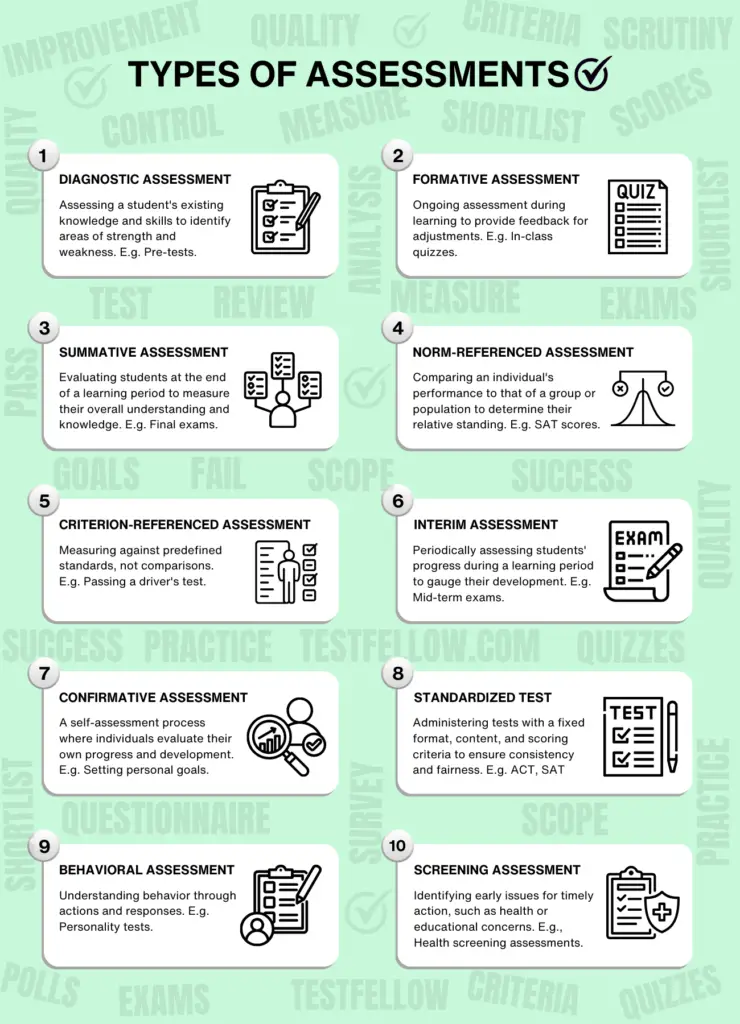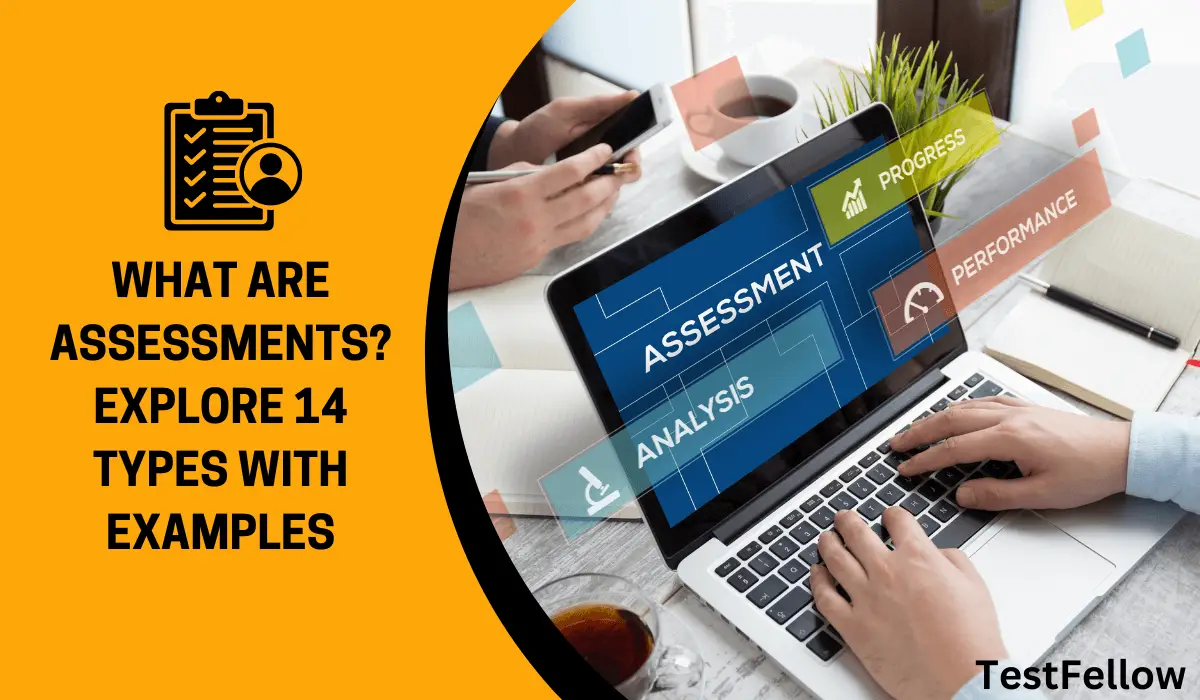Whether you’re a student or a working professional, assessments, frequently in the form of standardized tests, are something we’ve all faced at some point. From the classroom to the boardroom, from healthcare settings to the world of sports, assessments play a crucial role in measuring progress, identifying strengths and weaknesses, and guiding decision-making processes. In this comprehensive guide, we will explore what are assessments, their diverse types with examples, purposes, and the valuable insights they offer.
What are assessments?
Assessments refer to systematic processes and methods employed to evaluate, measure, or appraise various aspects of an individual’s knowledge, skills, abilities, or characteristics. These evaluations serve the purpose of providing valuable insights, often used for educational, professional, or personal decision-making. Assessments come in various forms, including tests, observations, and interviews, and are widely utilized across diverse fields and contexts to determine performance, progress, or suitability.
Assessments encompass a wide range of tools and methodologies designed to gauge an individual’s capabilities, spanning categories like psychometric assessments, personality tests, IQ tests, and aptitude assessments.
Purpose of Different Types of Assessments
Assessments serve as valuable tools in the realm of education, offering diverse insights into student progress and guiding teaching strategies. They typically fall into one of three primary purposes within a classroom setting:
- Assessment of learning
- Assessment for learning
- Assessment as learning
1. Assessment of Learning
This type of assessment is often employed to measure what students have learned and achieved at the end of a learning period or unit. Assessment of learning serves as a means to evaluate the outcomes and overall performance.
Assessments of learning frequently include a specific grade, serving as a means to convey students’ accomplishments to teachers, parents, students themselves, school-level administrators, and district leaders
Examples of Assessments of Learning
- Exams
- Portfolios
- Final projects
- Standardized tests
Common Types of Assessment of Learning
- Summative assessments
- Norm-referenced assessments
- Criterion-referenced assessments
2. Assessment for Learning:
Assessment for learning, also known as formative assessment, is used during the learning process to provide ongoing feedback and monitor student progress. Educators use this type of assessment to identify areas where students may need additional support or clarification. It informs instructional decisions, allowing teachers to adapt their teaching strategies in real-time to meet students’ needs.
Examples of Assessment for Learning:
- Quizzes
- Classroom discussions
- Peer assessments
- Homework assignments
Common Types of Assessment for Learning:
- Formative quizzes
- Peer evaluations
- Self-assessment journals
- In-class polls
- Homework assignments
- Peer feedback discussions
3. Assessment as Learning:
Assessment as learning occurs when students take an active role in assessing their own learning progress. This approach encourages self-regulation and reflection. Students engage in metacognition, evaluating their strengths and areas for improvement.
Examples of Assessment as Learning:
- Student-created portfolios
- Self-assessments
- Reflective journals
- Learning logs
Common Types of Assessment as Learning:
- Student-generated rubrics
- Self-reflection essays
- Goal-setting exercises
- Learning journals
- Personal progress reports
Types of Assessments
In this section, we’ll delve into 14 diverse types of assessments, each with its unique purpose and accompanied by examples.
1. Pre-Assessments (Diagnostic assessment)
Pre-assessments, also known as diagnostic assessments, are like the “health check” before starting a learning journey. Their primary purpose is to determine your current level of knowledge and skills in a specific subject or topic. These assessments help educators understand where you stand before they begin teaching, allowing them to tailor their instruction to your individual needs.
Examples:
- A brief quiz at the course start to gauge prior understanding
- Questions to assess previous knowledge about a topic
- Simple exercises demonstrating existing skills in a subject
2. Formative Assessment:
Formative assessment, often referred to as assessment for learning, is conducted during the learning process to provide ongoing feedback to both students and educators. Its primary purpose is to inform and adapt instruction in real time, helping students understand their progress and identify areas for improvement.
Examples:
- Quizzes
- Classroom discussions
- Homework assignments with feedback
- Peer assessments
- In-class polls
- Teacher observations and feedback
3. Summative assessment
Summative assessment, also known as assessment of learning, takes place at the end of a learning period or unit. Its primary purpose is to measure overall learning outcomes and determine the level of student achievement. Summative assessments often yield a final grade or score.
Examples:
- Final exams
- End-of-term projects
- Standardized tests (e.g., SAT, ACT)
- State or national assessments
- Graduation assessments
4. Confirmative assessment
Confirmative assessment is a self-assessment process that empowers individuals to actively evaluate their own progress and development. Its primary purpose is to help individuals understand how they are performing and make informed decisions about their learning journey. It encourages self-awareness and personal growth.
Examples:
- Setting study or skill improvement goals.
- Checking progress and identifying areas for improvement.
- Keeping a learning journal to record achievements and track development over time.
5. Ipsative assessment
Ipsative assessment is a unique type of evaluation that focuses on an individual’s performance relative to their own previous achievements. Instead of comparing against external standards or others, ipsative assessment measures personal growth and development over time. Its primary purpose is to track how an individual’s skills and knowledge have evolved, fostering self-awareness and personal improvement.
Examples:
- Comparing your current writing skills to your writing skills a year ago.
- Reflecting on your ability to solve math problems now versus a few months ago.
- Assessing how your public speaking skills have improved since your last presentation.
6. Interim assessment
Interim assessment is a type of assessment that occurs at specific intervals throughout a learning period, typically between formative and summative assessments. The primary purpose of interim assessment is to gauge student progress and understanding of the material. It provides teachers and educators with valuable insights into how well students are grasping the concepts and helps them adjust instruction accordingly.
Examples:
- Mid-semester quizzes
- Benchmark assessments
- Periodic standardized tests
7. Norm-referenced assessment
Norm-referenced assessment is a method of evaluation that compares an individual’s performance to that of a larger group, called a norming group or peer group. The primary purpose is to determine how an individual’s performance ranks or compares to the performance of their peers. It is often used to make relative judgments about an individual’s standing within a group.
Examples:
- Comparing a student’s test score to the average score of their classmates.
- Assessing an employee’s performance relative to the performance of colleagues in the same role.
- Determining how a candidate’s aptitude test results compare to the scores of others applying for the same position.
8. Criterion-referenced assessment
Criterion-referenced assessment is an evaluation method that measures an individual’s performance against specific predetermined criteria or standards. The primary purpose is to determine whether an individual has met established benchmarks or objectives. It is commonly used to assess mastery of particular skills, knowledge, or competencies.
Examples:
- A driver’s license test where individuals must demonstrate specific driving skills to pass.
- An academic exam with clear learning objectives, and students must meet a set standard to pass.
- A professional certification exam where candidates are evaluated against a predefined set of competencies.
9. Standardized test assessment
Standardized test assessment comprises conducting tests with a predetermined format, content, and scoring guidelines to guarantee uniformity and impartiality when appraising individuals’ performance. These assessments are crafted to gauge particular skills or knowledge and are usually carried out in regulated settings. Their main objective is to offer an impartial and consistent method for appraising and contrasting individuals’ capabilities.
Examples:
- SAT (Scholastic Assessment Test)
- GRE (Graduate Record Examination)
- ACT (American College Testing)
10. Performance-Based Assessments
Performance-based assessments are a dynamic way of evaluating an individual’s capacity to apply their knowledge and skills in real-life situations. These assessments primarily aim to evaluate practical competencies and problem-solving abilities. Unlike conventional tests with multiple-choice questions or essays, performance-based assessments demand individuals to showcase their skills through hands-on tasks or projects
Examples:
- Developing comprehensive analyses in essays
- Conducting laboratory investigations
- Completing original research papers
- Employees troubleshooting and resolving real-world technical issues
11. Behavioral assessment
Behavioral assessment involves systematically evaluating an individual’s actions and behaviors across different scenarios. It seeks to measure observable behaviors and uncover their root causes. The core objective of behavioral assessment is to provide insights into behavior patterns, emotions, and psychological states. This assessment is valuable in education, psychology, and clinical contexts.
Examples:
- Personality tests
- Behavioral checklists
- Role-playing simulations
- Behavioral interviews
12. Placement assessments
Placement assessments are evaluations conducted to determine an individual’s appropriate placement or level within an educational or vocational program. These assessments aim to assess an individual’s current knowledge, skills, and abilities to ensure they are placed in the most suitable and challenging learning environment. Placement assessments play a crucial role in matching students or individuals with the right educational or vocational track.
Examples:
- College course readiness assessments
- Vocational training skill level identification
- Language proficiency placement tests
13. Screening assessment
Screening assessment is a brief and preliminary evaluation conducted to identify individuals who may require further assessment, intervention, or support in a specific area. The primary purpose is to quickly identify potential issues or concerns, such as health problems, learning difficulties, or developmental delays. Screening assessments are often used as an initial step in a more comprehensive evaluation process.
Examples:
- Early childhood development screening to detect potential developmental delays in children.
- Health screening assessments to identify individuals at risk of specific medical conditions, such as diabetes or hypertension.
- Reading screening assessments in schools to identify students who may need additional reading support.
14. Peer assessment
Peer assessment involves individuals evaluating the work, performance, or contributions of their peers. Its primary aim is to gather valuable insights and feedback from those who share similar experiences or contexts. This method is extensively used in educational settings to encourage collaborative learning and offer students opportunities for assessment and learning from their peers.
Examples:
- In group projects, students assess the contributions and teamwork of their fellow group members.
- Peer assessment in writing workshops involves students providing feedback on each other’s essays or papers.
- In a training program, participants may assess the presentations or skills of their fellow trainees.
Each of these assessment types serves a unique purpose in the education process, contributing to a holistic understanding of student learning and development. Furthermore, they play a crucial role in aiding employers in identifying the most fitting candidates for specific roles.
Conclusion
In our comprehensive guide, we’ve illuminated the diverse world of assessments, spanning 14 distinct types, each with a distinct role in education and beyond. These assessments offer invaluable insights into our growth and capabilities. Armed with this knowledge, you now have a better understanding of assessments, empowering you to approach them with confidence and succeed in your educational and professional journey.
Types of Assessments Infographic

Related Articles:
- A Comprehensive Guide to 23 Types of Questions
- What Is a Psychometric Test – A Comprehensive Guide
- What is an IQ Test – A Comprehensive Guide
- What are Personality Tests – A Comprehensive Guide
- What are Aptitude Tests – A Comprehensive Guide
- What are MCQs? 24 Types with Examples
- What is a Test? 10 Types of Tests in Education
- Top 10 Tips to Prepare for a Psychometric Test
- How to Pass an Aptitude Test: Top 10 Effective Tips
- How to Prepare for Personality Tests: 10 Expert Tips
- How to Answer Multiple Choice Questions: 10 Tips

